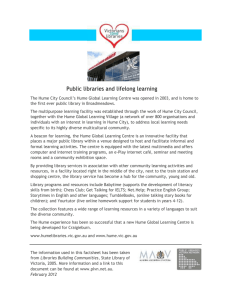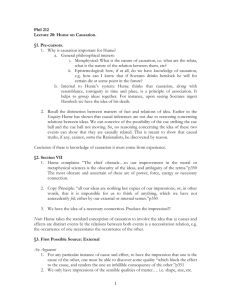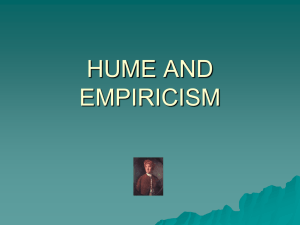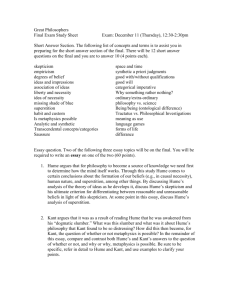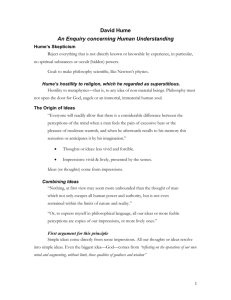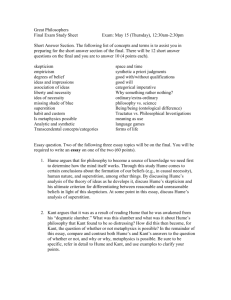Hume on causation
advertisement
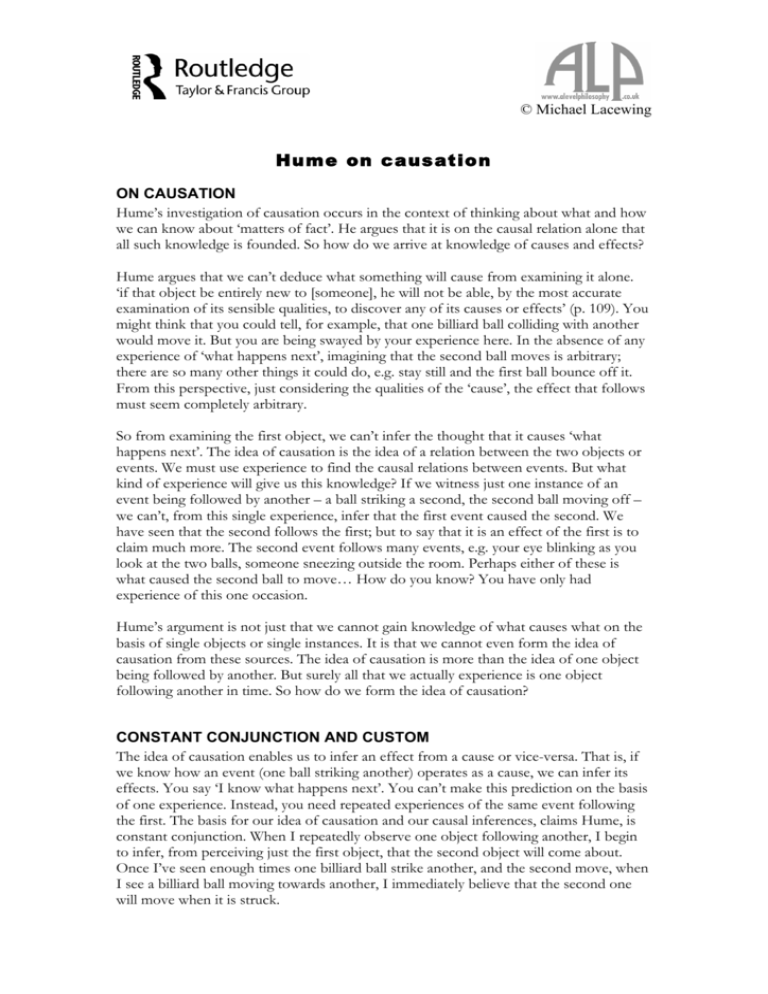
© Michael Lacewing Hume on causation ON CAUSATION Hume’s investigation of causation occurs in the context of thinking about what and how we can know about ‘matters of fact’. He argues that it is on the causal relation alone that all such knowledge is founded. So how do we arrive at knowledge of causes and effects? Hume argues that we can’t deduce what something will cause from examining it alone. ‘if that object be entirely new to [someone], he will not be able, by the most accurate examination of its sensible qualities, to discover any of its causes or effects’ (p. 109). You might think that you could tell, for example, that one billiard ball colliding with another would move it. But you are being swayed by your experience here. In the absence of any experience of ‘what happens next’, imagining that the second ball moves is arbitrary; there are so many other things it could do, e.g. stay still and the first ball bounce off it. From this perspective, just considering the qualities of the ‘cause’, the effect that follows must seem completely arbitrary. So from examining the first object, we can’t infer the thought that it causes ‘what happens next’. The idea of causation is the idea of a relation between the two objects or events. We must use experience to find the causal relations between events. But what kind of experience will give us this knowledge? If we witness just one instance of an event being followed by another – a ball striking a second, the second ball moving off – we can’t, from this single experience, infer that the first event caused the second. We have seen that the second follows the first; but to say that it is an effect of the first is to claim much more. The second event follows many events, e.g. your eye blinking as you look at the two balls, someone sneezing outside the room. Perhaps either of these is what caused the second ball to move… How do you know? You have only had experience of this one occasion. Hume’s argument is not just that we cannot gain knowledge of what causes what on the basis of single objects or single instances. It is that we cannot even form the idea of causation from these sources. The idea of causation is more than the idea of one object being followed by another. But surely all that we actually experience is one object following another in time. So how do we form the idea of causation? CONSTANT CONJUNCTION AND CUSTOM The idea of causation enables us to infer an effect from a cause or vice-versa. That is, if we know how an event (one ball striking another) operates as a cause, we can infer its effects. You say ‘I know what happens next’. You can’t make this prediction on the basis of one experience. Instead, you need repeated experiences of the same event following the first. The basis for our idea of causation and our causal inferences, claims Hume, is constant conjunction. When I repeatedly observe one object following another, I begin to infer, from perceiving just the first object, that the second object will come about. Once I’ve seen enough times one billiard ball strike another, and the second move, when I see a billiard ball moving towards another, I immediately believe that the second one will move when it is struck. So the idea of causation is derived from our experience of constant conjunction. This experience is, of course, past experience. Hume argues that our use of past experience to make inferences about the future – e.g. what will happen next when one ball strikes another – is not based on reasoning. Instead, it is based on custom, that principle of the mind that associates cause and effect, so that whenever we experience an event which has had particular effects in the past, we immediately think of the effect now. What sets up this ‘customary’ movement of the mind is our experience of constant conjunction. Again, it is important to note that we do not infer the effect by saying that because there has been constant conjunction in the past, this new instance (of a billiard ball moving towards another) will conform to it. Rather, the simple fact that we have experienced constant conjunction sets up the link between cause and effect in our minds. We can give two points in support of this claim: 1. We often don’t, and don’t need to, call on our memory when making the inference; e.g. when seeing a body of deep water, I immediately think that it could drown me, without calling to mind past experiences of this. 2. Animals are clearly capable of making these causal inferences (p. 118), but animals don’t construct arguments with general principles like ‘there has been constant conjunction in the past’. OBJECTION Is Hume right that we must always have repeated experience in order to associate cause and effect? At the end of §IV, he gives the example of a child feeling pain when putting its hand in the candle flame, and learning not to put its hand near the candle (p. 118). But how many times must a child do this before becoming cautious? If Hume is right, after being burnt just once, the child will not be cautious – not even a little bit, because without repeated experience, custom will not have set up the anticipation of being burned again. We can test this claim (a bit unethical, but possible!). I would predict that children burned just once would be cautious. If I am right, Hume’s account that the inference of effect from cause depends on repeated experience must be wrong. This would mean that the mind can identify a cause after just one instance. It can identify and select the relevant event (hand in candle) preceding the effect (burnt hand) as the cause, despite the many other events occurring at the same time. For example, as Hume notes in the Treatise (I.iii.ii), we expect the cause to be contiguous to the effect. If the pain is in my hand, then I expect what causes the pain to be near my hand. Only the candle flame fits the bill. Hume can reply that even if we can, in some cases, infer that one event causes another from a single instance, we nevertheless need experience of constant conjunction to form the idea of causation in the first place. (For instance, where does the expectation that a cause is contiguous to its effects come from?) The general claim that causal inference is based on custom, and custom is based on constant conjunction would remain, even if in certain instances we can make a particular causal inference from experiencing just one instance of cause-effect. THE IDEA OF NECESSITY To say that one event causes another, we commonly think, is not just to say that the second follows the first (constant conjunctino), but that the second must follow the first. Hume first refers to this idea in §IV – ‘the supposed tye or connexion between the cause and effect, which binds them together, and renders it impossible, that any other effect could result from the operation of that cause’ (111). (Hume takes this idea of necessary connection to be equivalent to the idea that the cause has the power to bring about its effects. We shall not discuss this assumption, but focus just on necessary connection.) Experience shows us what follows what; but, Hume argues, experience does not show us that the effect must follow. Since we have this idea of a necessary connection, so Hume must explain its origins in accordance with his theory of ideas. What is the impression from which the idea is derived? The search Hume begins with our experience of the events themselves. There is no impression of the ‘necessary connection’ deriving from our sense experience of the objects. If there were, then even in one instance of seeing an event cause its effect, we would immediately have the sense that the second event had to follow. But, he has argued, we don’t. There is no impression that the effect had to occur just as it did. How about constant conjunction? Could we gain an impression of necessary connection through repeated experience? This can’t be right either. Surely everything we can experience that belongs to the objects is there, present, is just one occasion. Repeating the succession of events doesn’t change the objects themselves. So we don’t derive the idea of a necessary connection from looking to the objects. If it is not an impression of sense, could it be an impression of reflection? Hume considers and rejects the suggestion that the idea derives from our experience of willing (pp. 137-40). The necessary connection would connects one’s will as the cause to its effects, e.g. moving part of one’s body. But we have very little sense of what connects our will to its effects; we just will and the effect follows. How the two are connected, we have no impression of. We experience only a succession of events. Hume then turns (p. 141) to the philosophical theory that the connection between cause and effect is the will of God. It is God who brings about the effect when the cause occurs. But if we have no idea of the connection between the cause and the effect, we certainly have no idea of the will of God! The theory is unpersuasive and certainly no explanation for the origin of the idea of necessary connection. The idea of necessary causation is part of the idea of causation, and this, Hume has argued, derives from the relation of constant conjunction. This relation, as already argued, doesn’t change the objects or our sense impressions of them. But the experience of constant conjunction does change the mind. What has changed is that after a repetition of similar instance, the mind is carried by habit [custom], upon the appearance of one event, to expect its usual attendant, and to believe that it will exist. This connexion, therefore, which we feel in the mind, this customary transition of the imagination from one object to its usual attendant, is the sentiment or impression, from which we form the idea of power or necessary connexion. (p. 145) So Hume claims that the idea of necessary connection, an essential component of the idea of causation, derives from an impression of reflection. When we experience constant conjunction between objects or events, our minds develop a tendency to move automatically from the experience of one to a belief in the occurrence of the other, the principle of the imagination being ‘custom’. We experience this automatic movement, and it is the feeling of this movement, that is the impression from which we form the idea of necessary connection. The imagination has connected the two events; and the movement of mind from one to the other happens automatically, outside our will. We thereby come to believe that the events themselves are necessarily connected. THE IMPLICATION To say that two objects are necessarily connected, Hume argues, can have no other meaning than that they have acquired this association in our minds. We have a tendency to form the belief that the objects resemble our impressions of reflection. We ‘project’ onto the objects what actually originates in our minds. (Hume argues that this tendency is widespread. It occurs with secondary qualities, aesthetic properties and moral properties. We think objects are themselves coloured or beautiful, that actions are right or wrong; but in each case, the idea (colour, beauty, right) derives from an impression of reflection, not sense.) We can have no reason to suppose objects themselves are necessarily connected. If the property of necessary connection was in the two objects, we would be able to infer causes and effects from a single instance. This result does not mean that we should abandon all talk of necessary connection as mistaken. But it does mean that we must recognise that this way of talking is an expression of our experience not a description of objects as they are independent of our experience of them. IS HUME’S ACCOUNT CIRCULAR? Experiencing constant conjunction leads the mind to set up a connection in imagination between the two events. So Is the new habit of the mind an effect of experiencing constant conjunction? In the Treatise I.iii.xiv, Hume explicitly says that it is. Given that he is trying to analyse causation, is this a problem? Doesn’t he have to assume the idea of causation in his explanation of the idea of causation? We can reply that we can analyse his claim that experience of constant conjunction causes us to connect the events by custom using his account, viz. that experience of constant conjunction is constantly conjoined to our minds connecting the events experienced; and that on experiencing (or reflecting on) constant conjunction, our minds move automatically to the idea of a transition of the mind (custom). We might well doubt this! It has taken a lot of hard work on Hume’s part to demonstrate the connection between experience of constant conjunction and custom – hardly an automatic transition. What this shows is that the discovery of certain causal connections – and many examples from science suggest themselves, e.g. smoking and cancer – is not itself automatic, but depends on much thought and investigation. Hume’s theory does not deny this. He claims that the idea of cause originates, in part, in something that does happen automatically; and that in coming to believe that two events are causally related, our minds move from one to the other automatically. But Hume does not comment on how the production of this belief may, in some cases, require reflection on our experience. This again highlights how causal inference can, in many cases, operate as a form of reasoning. HUME’S DEFINITIONS OF ‘CAUSE’ Hume ends his discussion in §VII by providing two definitions of ‘cause’, one that refers to the relation between the objects themselves, the other that relates the objects to the mind of the observer. It is worth quoting the passage in full, to try to understand why he gives two definitions, not just one. Similar objects are always conjoined with similar. Of this we have experience. Suitably to this experience, therefore, we may define a cause to be an object, followed by another, and where all the objects similar to the first are followed by objects similar to the second. Or in other words, where, if the first object had not been, the second never had existed. The appearance of a cause always conveys the mind, by a customary transition, to the idea of the effect. Of this also we have experience. We may, therefore, suitably to this experience, form another definition of cause; and call it, an object followed by another, and whose appearance always conveys the thought to that other. (146) These two definitions of ‘cause’ are not equivalent. The first definition of cause picks out an objective relation between the objects; the second picks out a relation between the objects and our minds. Two objects could stand in the relation of constant conjunction without anyone knowing it – so the appearance of one does not convey thought to the second. Or again, our thought may be conveyed from one to the other – because they have been conjoined in our experience so far – even though the two objects are not constantly conjoined, and in unobserved cases come apart. Does Hume intend that something is a cause only if it satisfies both conditions? He does not say so. Judging from the context of discussion, we can say instead that Hume is giving us two views of causation. To understand causation, we must take into account both what goes on in the world, and our experience of that. Either without the other would miss out an essential part of our concept of cause. Objections However, both definitions are problematic. The first definition is that of ‘constant conjunction’. It reduces causation to simple ‘regularity’, the regularity of one event following another. But this faces two objections. First, Hume refers to causes being ‘similar’. But he does not, at any point, give us guidance on what counts as similar. And judgments of similarity are famously dependent on the mind of the observer. But if what counts as ‘the same thing as’ this object are subjective, then the relation of causation will be subjective. Yet the first definition clearly intends to pick out causation as it applies to objects (not our experience of them). Hume’s available only response is to argue that similarity is not always subjective, that some objects just are objectively similar to each other; and that real causal relations are the ones that hold between these objects. But this is not a very Humean idea. Second, there is a difficulty in distinguishing between constant conjunctions that are accidental from ones which are genuinely causal. For example, it just so happens that you and I both finish work at 5.00pm. I set the alarm on my computer to go off at this time. And so it occurs that every time my alarm goes off, you stop work. But my alarm has not caused you to stop work. We can reply that we only need to introduce the idea, present in the Treatise, that the objects related as cause and effect are contiguous to each other as well. But, in fact, Hume does not claim that cause and effect must be spatially contiguous, only temporally. Even if we did introduce spatial contiguity, there are counterexamples to this. For example, night follows day; but day does not cause night.] The counterfactual analysis of causation In response, Hume can appeal to the supplementary sentence, that ‘if the first object had not been, the second would never had existed’. This is a counterfactual analysis of causation (very popular among philosophers today). (A counterfactual is a conditional statement, in which the first clause picks out a state of affairs that is contrary to fact, e.g. ‘if the water hadn’t spilled, the table would be dry’, which implies that the water did spill.) This does answer the objection – for instance, it is not true that if my alarm hadn’t gone off, you wouldn’t have stopped work. But this is a completely different idea from mere regular succession, and not one that Hume has addresses in any part of his discussion so far. The counterfactual analysis itself continues to face problems. When is it true to say that ‘if the water hadn’t spilled, the table would be dry’; and does this always capture the cause? Suppose, in the actual situation, I am trying to balance the water glass and a wine glass; and if the water hadn’t spilled, this would be because I had taken my concentration off the wine glass to steady the water, and so the wine would have spilled – so the table would be wet. The counterfactual turns out false, and yet it is obvious that the water spilling is the cause of the water being wet in the actual situation. The second definition faces a different kind of problem, viz. that it is circular. To rephrase: A cause is an object, followed by another, whose appearance causes the mind to think of that other. To avoid the circularity, we must understand the appearance of cause within the definition in terms of the first definition. In other words, a cause is ‘an object, followed by another, whose appearance to the mind is followed by the idea of the second object, where all the objects similar to the first are followed by a similar transition in the mind to objects similar to the second object’. This means that the second definition cannot stand on its own, but is dependent on the first. The objections to the first definition therefore become all the more important, because Hume’s whole definition of causation depends on it.
